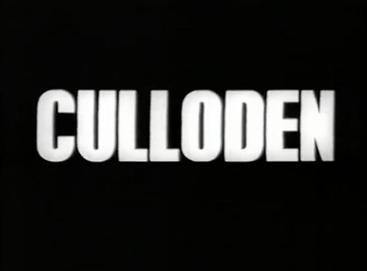April 16 is the anniversary of the Battle of Culloden. It took place in 1746 and ended the Jacobite rising that sought to put Bonnie Prince Charlie on the throne of England.
“Culloden” (“The Battle of Culloden” in America) was the first feature film of director Peter Watkins. He also wrote the screenplay, based on the book by historian John Prebble. Watkins pioneered the docudrama style and it works well here. The movie is very low budget. All of the actors were amateurs and the production had one cannon that had to perform for a battery. But Watkin’s cameraman was up to the task. A lot of it was shot with a hand-held camera. Watkins was inspired by war reporting. This includes interviews with the characters and a live feed feel from the narrator.
The movie opens with the preview that it will cover “one of the most mishandled and brutal battles ever fought in Britain.” Culloden took place on April 16, 1746. It was the last battle in Bonnie Prince Charlie’s rebellion against George II. The leaders on both sides are introduced and critiqued. The narrator can be brutal. The Scottish leaders outline their strategy and dysfunctional grievances against each other. Prince Charles leads an exhausted, hungry, and demoralized band of rebels. While he is confident that he will win because God wills it, his men beg to differ and his only competent general, Lord George Murray, thinks the battlefield is a deathtrap. The movie gives equal coverage to the common soldiers. They are identified and interviewed. They have various reasons for fighting, like personal revenge, but most are being forced to by the clan system which requires “human rent” for their chiefs. Less coverage is given to the British because their situation was more straight-forward. The Duke of Cumberland is putting down a rebellion and has quality troops to do it with. Watkins shrewdly has a British observer who acts as our guide to events in the battle. He shows a rough sketch of the battlefield that is helpful in orienting the audience.
The battle opens with that one cannon doing multi-duty for both sides. And it recoils! The stationary Scots are bombarded with decent sound and explosion effects for such a low budget film. There is literally a fog of war effect from all the legit powder smoke. This eventually leads to a melee that features a lot of yelling and something you don’t get it even modern war movies – wounded men screaming in pain. That’s right, not everyone dies when they are hit. If you are British, you know how this ends. If you are a Yank, you are probably expecting an upset in spite of all the odds. If you are a Scot, you aren’t watching this movie.
“Culloden” is a remarkable achievement by Watkins. He makes the most of his resources, unlike most unimaginative and uncreative low budget war movie makers. He certainly gets the best out of his amateur actors. Not that they don’t come off as amateurs. But then, most of the Scots were amateurs. And they look like men who at the end of a tough campaign. One British soldier remarks that he has not changed his clothes in six weeks. You do not want to see this movie in smell-o-vision. Or in high definition, because there are some homely people in this cast. Kudos to the makeup artist, but maybe pull the camera back a bit. Most of the cast must have been reenactors. The uniforms and weapons look authentic. As are the snare drums and bagpipes.
I am partial to docudramas as war movies. You get the battle acted out in an accurate way because the producer is cognizant of the importance of history. In fact, usually all the participants are motivated to get it right. Watkins made the good decision to substitute historical characters being interviewed instead of talking-head historians. He may not have given historians face time, but John Prebble is well-represented as the movie has no major historical flaws. We get clear background on the situation before the battle, a visceral reenactment of the battle, and then a sobering section on the aftermath of the battle. If the movie was just a patriotic BBC made-for-TV special, it would not have included the depressing results of the battle. Watkins was not making a puff piece. Both sides are treated fairly. The Scots were born losers, but the British were poor winners. There is no glory here for either.
“Culloden” clocks in at a tidy 1:12. It is available on YouTube. I recommend you view it if you want to learn about the Battle of Culloden or if you just want to see a different style of war movie. Then compare it to Mel Gibson’s Battle of Falkirk and tell me which one does justice to history.
GRADE = B

I had an ancestor at Culloden. He fought for Prince Charlie. This has been passed down in the family.
ReplyDeleteHe survived Culloden and ended up in the Carolinas. When I see the movie I can feel it.
Culloden is more historically accurate than Mel Gibson's version of the Battle of Falkirk. If you are filming the Battle of Falkirk Bridge, it would help to have a bridge.
Gibson said in his commentary for the Braveheart DVD it worked better (or was easier to film) without the bridge.
Don't get me started on Braveheart. You mention probably the biggest of my many complaints about how that movie rapes history.
Delete